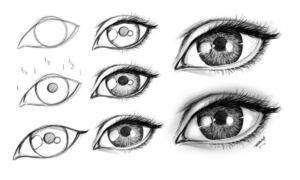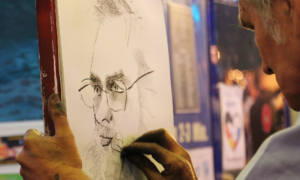The world of sketching is a diverse and captivating realm, with each artist wielding their own unique style and technique. Whether you’re a budding artist or an experienced sketcher, selecting the right pencils for your sketching style is essential. Pencils come in various grades and types, each suited for different purposes. In this comprehensive guide, we’ll explore how to choose the perfect pencils that align with your sketching style .
The world of art is as diverse as it is captivating, with countless styles and techniques waiting to be explored. For those who express their creativity through sketching, selecting the right pencils is the first step in the journey. The choice of pencils is not just a matter of personal preference; it’s a critical decision that can profoundly influence the outcome of your artwork. In this guide, we will explore the art of choosing the right pencils for your sketching style, helping you unlock your full artistic potential and bring your creative vision to life. Whether you’re an aspiring artist or a seasoned sketcher, understanding the nuances of pencil selection is an essential skill that can elevate your craft. Let’s embark on this journey together and discover the world of sketching pencils.
1. Versatile pencils for all styles
Pencils are the artist’s trusty companion, an essential tool that brings imagination to life. While there is an extensive array of specialized pencils catering to specific artistic styles, versatile pencils, typically found in the F to HB range, are the unsung heroes that can adapt to virtually any style of drawing. In this comprehensive exploration, we delve into the world of these versatile pencils and their remarkable ability to serve artists across diverse artistic genres.
The Versatile Pencil: F to HB
Versatile pencils typically fall within the F to HB grade range. They are characterized by their moderate hardness, striking a balance between harder and softer grades. Here’s what makes these pencils so versatile:
- Moderate Hardness: Pencils in the F to HB range possess a moderate level of hardness, making them perfect for achieving both fine lines and subtle shading. They’re not too hard to prevent shading and not too soft to lose precision.
- Clean Lines: These pencils excel at producing crisp, well-defined lines. This feature is particularly useful for outlining, adding details, or any artwork requiring precision.
- Shading Capabilities: While F to HB pencils may not deliver the darkest blacks or the softest gradients, they are fully capable of producing smooth transitions and subtle shading when applied with varying pressure.
- Erasability: Versatile pencils are easy to erase without leaving excessive smudging or unsightly marks, which facilitates the correction of errors or modifications in your artwork.
2. Realism
Realism is a captivating and demanding style of art that aims to depict subjects as they truly appear in the physical world. It requires an acute attention to detail, precision, and the use of various techniques to create lifelike and accurate representations. In this comprehensive exploration, we delve into the world of realism, offering insights into the techniques, tips, and inspiration that can help artists master this challenging but rewarding artistic style.
Understanding Realism
Realism is an artistic style that originated in the 19th century, and it stands in contrast to more abstract and impressionistic approaches. The primary goal of realism is to create artworks that closely resemble the subject, displaying minute details, textures, and achieving an accurate portrayal of light and shadow. Key characteristics of realism include:
- Precision: Realism demands precision and attention to detail. Artists must carefully observe the subject to capture its features accurately.
- Tonal Range: Achieving a wide tonal range, from the darkest shadows to the brightest highlights, is essential in realism to give the artwork depth and three-dimensionality.
- Texture: Realistic artists often focus on recreating textures such as skin, fabric, or the grain of wood to create a lifelike appearance.
- Accuracy: Realism often involves creating works that are indistinguishable from photographs, showcasing the artist’s skill in replicating reality.
Techniques for Achieving Realism
To create realistic artwork, artists employ various techniques that set the stage for precise and detailed representations:
- Observation: The foundation of realism lies in careful observation. Artists must keenly observe the subject to understand its proportions, colors, and details.
- Grid Method: The grid method involves dividing the subject and the drawing into a grid, allowing for precise scaling and placement of details.
- Layering: Building up layers of graphite or other media is a common technique for achieving tonal depth and smooth transitions in realistic artwork.
- Blending and Smudging: These techniques involve softening edges and blending tones to create a more realistic appearance, particularly in areas like skin or fur.
- Use of Reference: Many realistic artists use photographic references to ensure accuracy and detail in their work.
Tips for Aspiring Realists
Mastering realism is a challenging endeavor, but it’s incredibly rewarding. Here are some tips to help aspiring realists on their journey:
- Practice Regularly: Like any art form, realism improves with practice. Create a daily or weekly routine to hone your skills.
- Study Anatomy: Understanding human and animal anatomy is crucial for realistic depictions of figures and creatures.
- Use High-Quality Materials: Quality art supplies can make a significant difference in achieving realism. Invest in good paper, pencils, and other materials.
- Work on Your Patience: Realistic art takes time. Be patient and don’t rush the process. It’s about precision and detail, not speed.
- Seek Feedback: Share your work with fellow artists or mentors to receive constructive feedback. Learning from others can accelerate your progress.
Inspiration for Realism
Finding inspiration for realistic artwork can come from a variety of sources:
- Nature: The natural world is filled with intricate details, textures, and colors. Wildlife, landscapes, and flora can provide endless inspiration.
- Portraiture: Capturing the expressions, features, and personalities of people can be a deeply rewarding aspect of realism.
- Everyday Life: Mundane or ordinary objects can become fascinating subjects in the hands of a realist artist, highlighting the beauty in the commonplace.
- Art History: Studying the works of master realists such as Caravaggio, Vermeer, or contemporary artists like Chuck Close can offer valuable insights and inspiration.
- Photography: High-quality photographs can serve as references for creating realistic artworks. You can draw from your personal collection or explore various online resources.
3. Impressionism
Impressionism is one of the most beloved and influential art movements in the history of Western art. Emerging in the late 19th century, this style represents a departure from the meticulously detailed and realistic art of the past. Instead, Impressionism emphasizes the fleeting, ever-changing nature of light and color. In this detailed exploration, we will delve into the world of Impressionism, examining its techniques, characteristics, and showcasing some of its iconic masterpieces.
Understanding Impressionism
Impressionism is characterized by the following key features:
- Capturing Moments: Impressionist artists aimed to capture a single moment in time, often depicting scenes from everyday life.
- Light and Color: The movement is known for its focus on the effects of light and color. Impressionists used vibrant, unblended colors to represent the changing play of light.
- Brushwork: Instead of meticulously blended brushwork, Impressionists employed visible, broken brushstrokes, allowing viewers to see the individual colors and shapes that make up the image.
- Outdoor Painting: Many Impressionists preferred to work outdoors, en plein air, to observe and capture natural light and its transformative effects.
- Movement and Atmosphere: Impressionist paintings often convey a sense of movement, atmosphere, and an overall “impression” rather than precise detail.
Techniques of Impressionism
Impressionism is defined by distinct techniques that set it apart from other art movements:
- Short Brushstrokes: Artists used short, distinct brushstrokes to capture the play of light and create the sensation of movement and life in their paintings.
- Optical Mixing: Impressionists allowed the viewer’s eye to blend colors optically, rather than mixing them on the palette. This results in vibrant, flickering surfaces.
- En Plein Air: Working outdoors allowed artists to observe the ever-changing natural light, lending authenticity to their depictions of scenes.
- Color Theory: Impressionists explored the color wheel and the use of complementary colors to create vibrant contrasts and harmonies in their work.
Characteristics of Impressionist Art
Impressionism is characterized by several distinct qualities:
- Play of Light: Impressionists sought to capture the transient quality of light, often depicting scenes at different times of day to explore the variations in light and color.
- Everyday Subjects: Common, everyday subjects such as landscapes, cityscapes, and scenes of leisure were popular among Impressionist artists.
- Focus on Atmosphere: Impressionist works evoke the mood and atmosphere of a scene rather than attempting to reproduce minute details.
- Depiction of Movement: Many Impressionist paintings convey a sense of movement, whether through the use of brushstrokes or the portrayal of figures in motion.
- Rejection of Traditional Rules: Impressionism challenged traditional artistic norms and rejected the academic approach to art.
Iconic Impressionist Masterpieces
Impressionism boasts a collection of iconic masterpieces that have left a profound impact on the art world. Here are a few notable works:
- “Impression, Sunrise” by Claude Monet: This painting, which gave the Impressionist movement its name, captures a fleeting moment of sunrise over a harbor. Monet’s use of light and color creates a stunning impression of the scene.
- “Starry Night” by Vincent van Gogh: While Van Gogh is often associated with Post-Impressionism, this painting showcases his unique approach to capturing the movement and essence of the night sky.
- “Dance at Le Moulin de la Galette” by Pierre-Auguste Renoir: This masterpiece conveys the vivacious atmosphere of a dance at an open-air cafe, with Renoir’s signature depiction of people and their joyful interactions.
- “Water Lilies” series by Claude Monet: Monet’s series of water lily paintings exemplify his fascination with the play of light on water and the transformative effects of changing seasons.
- “Woman with a Parasol – Madame Monet and Her Son” by Claude Monet: A beautiful portrayal of Monet’s wife and son in a sunlit field, capturing the Impressionist’s love for family and the effects of light.
4. Comic and Cartoon
Comics and cartoons are two dynamic and highly influential forms of visual storytelling. They entertain, inform, and often serve as a reflection of contemporary culture. In this comprehensive exploration, we delve into the world of comics and cartoons, shedding light on their techniques, styles, and iconic figures.
Understanding Comics and Cartoons
Comics are a visual medium that combines illustrations and text to tell a story. They can be in the form of comic strips (short, self-contained narratives) or comic books (longer, serialized stories).
Cartoons, on the other hand, are single-panel or short, animated pieces that are often humorous or satirical in nature. Cartoons can be found in editorial illustrations, animated television shows, or web animations.
Techniques in Comics and Cartoons
- Panel Layout: In comics, the arrangement of panels on a page is crucial for controlling the pacing and flow of the narrative. Creative panel layouts can add depth and dimension to the story.
- Word Balloons: Dialogue and narration are typically conveyed through word balloons in comics. The placement and design of word balloons can influence the reader’s interpretation of the story.
- Inking: In comics, inking refers to the process of refining and enhancing pencil drawings with ink. It provides clarity, contrast, and detail, which is essential in comic art.
- Lettering: Lettering involves the creation of fonts or handwriting styles for dialogue and captions. The choice of lettering style can affect the tone and mood of the story.
- Character Design: Strong character design is central to both comics and cartoons. Characters need to be visually distinct and expressive to engage the audience.
Styles in Comics and Cartoons
- Manga: A popular style originating from Japan, manga is characterized by its distinctive art style, often featuring large, expressive eyes and a wide range of themes, from action to romance.
- Superhero Comics: This genre, epitomized by publishers like DC and Marvel, focuses on larger-than-life characters with extraordinary powers, intricate story arcs, and action-packed scenes.
- Webcomics: The digital age has given rise to webcomics, offering a diverse range of art styles, genres, and storytelling techniques. They are accessible to a global audience online.
- Political Cartoons: Editorial or political cartoons use satire and caricature to comment on current events, often with a strong dose of humor and social critique.
- Underground Comics: These comics often tackle controversial or countercultural themes, with more experimental and alternative art styles.
Icons of Comics and Cartoons
- Superman: Created by Jerry Siegel and Joe Shuster in 1938, Superman is one of the most iconic superheroes in comic book history. His symbol, the “S,” is instantly recognizable.
- Mickey Mouse: Created by Walt Disney and Ub Iwerks in 1928, Mickey Mouse is not only an animation legend but also an iconic figure in the world of comics and cartoons.
- Calvin and Hobbes: The creation of Bill Watterson, Calvin and Hobbes is a beloved comic strip that ran from 1985 to 1995, known for its wit, depth, and exploration of imagination.
- The Peanuts Gang: Charles M. Schulz’s “Peanuts” is a timeless comic strip that introduced iconic characters like Charlie Brown, Snoopy, and Lucy, dealing with the complexities of childhood.
- Spider-Man: Created by Stan Lee and Steve Ditko in 1962, Spider-Man is a beloved Marvel superhero with a compelling narrative and a distinctive red-and-blue costume.
5. Architectural Sketches
Architectural sketches are a vital aspect of the design and creative process in architecture. These sketches provide architects and designers with a means to explore ideas, communicate concepts, and convey their vision for a structure. In this detailed exploration, we will delve into the world of architectural sketches, examining their purpose, techniques, and their role in the evolution of architectural design.
Understanding Architectural Sketches
Architectural sketches are hand-drawn or digitally rendered representations of architectural designs, concepts, or details. They serve various crucial purposes in the field of architecture:
- Design Exploration: Sketching is an early-stage tool for architects to brainstorm and explore design ideas, from the overall form of a building to interior layouts.
- Communication: Sketches allow architects to communicate their vision with clients, colleagues, and builders, making complex design concepts more accessible.
- Visualization: Sketches provide a tangible visualization of a design, allowing architects to evaluate proportions, spatial relationships, and aesthetics.
- Problem Solving: Architectural sketches can be used to address and solve design challenges or issues that may arise during the planning and construction phases.
Techniques for Architectural Sketching
Architectural sketching employs a variety of techniques to convey design intent effectively:
- Perspective Drawing: Using one-point, two-point, or three-point perspective, architects can create realistic representations of buildings and spaces, conveying depth and dimension.
- Freehand Drawing: Freehand sketching allows for quick and expressive representations of ideas. It’s an essential skill for architects, enabling them to rapidly convey concepts.
- Line Weight and Shading: By varying line weight and applying shading techniques, architects can create a sense of depth, texture, and contrast in their sketches.
- Hatching and Cross-Hatching: These techniques involve the use of parallel or intersecting lines to add shading and texture to a sketch, conveying materials and details.
- Axonometric and Isometric Drawing: These methods provide a clear, three-dimensional representation of architectural elements and structures, often used for technical drawings.
The Role of Architectural Sketches in the Design Process
Architectural sketches play a crucial role in every phase of the design process:
- Conceptual Phase: Early sketches help architects brainstorm and refine their design concepts, exploring various possibilities.
- Schematic Design: Architects use sketches to communicate and gain approval for initial design concepts with clients and project stakeholders.
- Design Development: As the design progresses, sketches evolve into more detailed drawings, which may include interior layouts and structural elements.
- Construction Documentation: Architects produce precise technical drawings and construction documents based on the refined sketches to guide builders in the construction phase.
- Presentation: High-quality, aesthetically pleasing sketches are often used for presentations to clients and in architectural competitions.
Digital Tools in Architectural Sketching
While traditional hand-drawing remains integral to architectural sketching, digital tools have become increasingly popular. Software like AutoCAD, SketchUp, and Adobe Photoshop enables architects to create, edit, and present sketches in a digital format. Digital tools offer precision, flexibility, and the ability to easily incorporate changes, making them valuable in modern architectural practices.
Iconic Architectural Sketches
- Le Corbusier’s Villa Savoye: The architectural sketches for this iconic modernist villa reveal Le Corbusier’s groundbreaking design principles and concepts of the “Five Points of Architecture.”
- Frank Gehry’s Guggenheim Museum Bilbao: Gehry’s expressive hand sketches helped define the unique and fluid form of this world-famous building.
- Eero Saarinen’s Gateway Arch: Saarinen’s sketches convey the graceful, arching design of this St. Louis landmark, showcasing the power of simple, expressive lines.
- Louis Kahn’s Salk Institute: Kahn’s sketches for the Salk Institute illustrate his meticulous attention to detail and the balanced use of light and space in the design.
Learn more about choosing pencils for sketching style…
If you found this blog on architectural sketches informative and inspiring, you might also be interested in our previous blog titled “Choosing the Right Pencils for Your Sketching Style: A Comprehensive Guide.” In that guide, we delve into the world of sketching pencils and provide detailed insights into selecting the perfect pencils that align with your unique sketching style, be it realism, impressionism, comics, architectural sketches, or sketch journaling. It’s a valuable resource for artists looking to understand the different pencil grades and how they suit various artistic approaches. Feel free to check it out for more insights into the world of sketching and the tools that make it all possible.
Watch this tutorial to know more about choosing pencils for sketching style :
How to Choose the Right Pencil
Conclusion
Choosing the right pencils for your sketching style is a critical decision that can significantly impact the quality and expression of your artwork. Throughout this comprehensive guide, we’ve delved into the nuances of selecting the perfect pencils that align with your unique artistic approach. Whether you’re a budding artist or a seasoned sketcher, it’s clear that your choice of pencils can be a game-changer in your creative process.
We’ve learned that pencil grades, ranging from hard to soft, offer distinct characteristics that cater to various sketching styles. The 9H to 4H pencils provide fine lines ideal for technical drawings, while the 3H to H range strikes a balance between precision and depth, suitable for general sketching and outlining. The F to HB pencils, being moderately hard, offer versatility by delivering both precision and shading capabilities. The B to 9B pencils, on the other hand, are the go-to choice for creating bold, expressive sketches with rich, dark lines and broad shading.
Moreover, understanding your sketching style is paramount. Realism, impressionism, comics, architectural sketches, and sketch journaling each have unique demands, and choosing the right pencils tailored to your style can greatly enhance your work.
Remember that there is no one-size-fits-all answer when it comes to choosing pencils for your sketching style. Your preferences may evolve as your skills and style develop. Therefore, experiment, practice, and enjoy the process of finding the perfect pencils that bring your artistic vision to life.
Whether you’re recreating reality with meticulous detail, capturing the fleeting beauty of a moment, telling stories through comics, designing architectural wonders, or journaling your experiences, the right choice of pencils is the bridge between your imagination and the canvas. Happy sketching!




